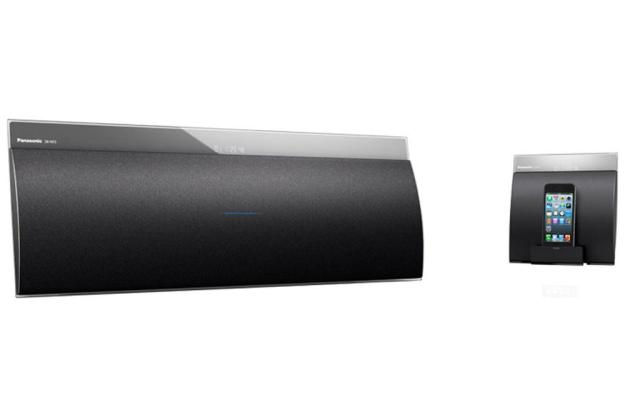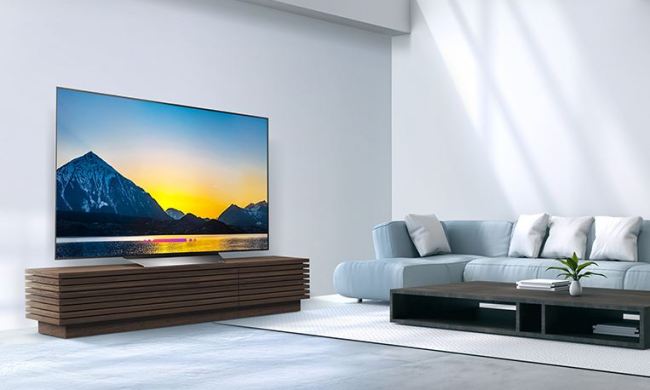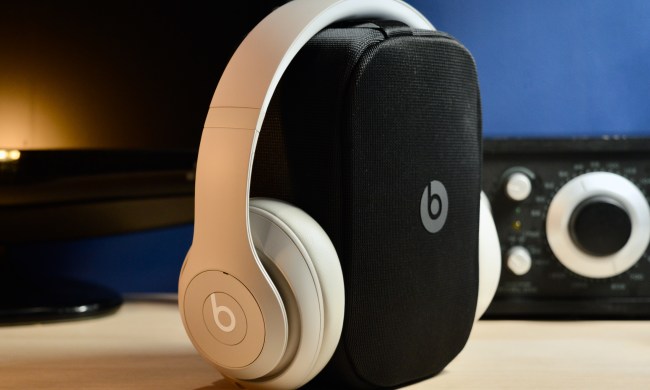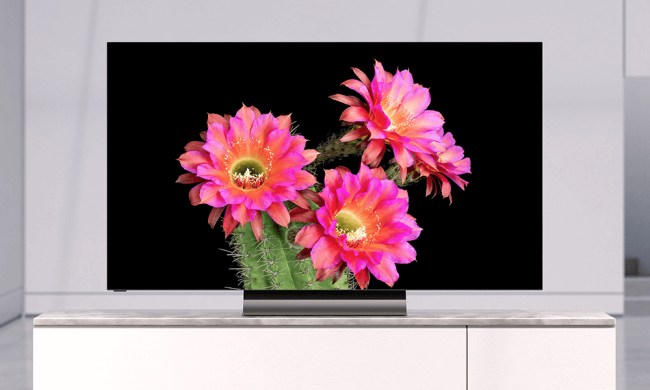
“The Panasonic SC-NE5’s massive feature set, excellent sonic signature, and unique design make it one of the most versatile wireless speaker systems we’ve encountered.”
- Clear and detailed sound signature
- Warm, full bass
- Convenient, feature-packed design
- Excellent wireless signal
- CD player doesn’t offer notable sonic benefit
- Expensive
In case you missed the memo, we’re in the middle of a wireless speaker revolution. And thankfully, the trail blazed by the tinny-sounding, limited-range pioneers of yesteryear has given way to an increasing array of stellar-sounding, stylish speakers that can deliver virtually every recording in existence from the palm of your hand. Still, those who came up in the days before iPhones and Spotify will notice that the original digital music darling seems to have been left for dead in this new wireless world. We’re speaking, of course, of the CD.
Panasonic aims to change that with its SC-NE5 (NE5). Priced around $400 online, this two-piece audio system comprises a modern wireless speaker mated with a satellite dock that’s armed with both a Lightning connection for iOS devices and a CD player. For those reluctant to spend hours ripping discs, the NE5 offers wireless access to an entire music collection, no matter the format. We recently spent some time with the system to measure its merits. Here’s what we found.
Out of the box
Panasonic’s website makes the NE5 look pretty sleek and classy in photos, but we felt a little let down when we pulled the system from its box. Although the speaker has some smooth curves and a snazzy mirrored panel across the top, the satellite dock feels flimsy. The plastic is dainty and the unit is suspiciously light. The result is the sort cheap feeling you might expect to get from a $100 boombox.
Features and design
The NE5’s main speaker gives off a semi-futuristic vibe, thanks to its wavy front face and horizontal, blue LED at the center of the speaker screen. Above the screen sits a strip of smoked chrome, with a small digital display peeking from behind the tinted glass at the center. The display shows the input source and guides you through the system’s respectable array of digital features. At the back panel are two small sound ports sitting above a recessed chamber that hosts jacks for power and an FM antenna. The back panel also hosts slots which, along with included hardware, allow for wall mounting the speaker (it should be noted that we didn’t test audio in that configuration).
The NE5 is one of those rare speakers that seemed to get better and more detailed the longer we listened.
The onboard controls are all well and good (and completely necessary for initial setup), but navigation of the system’s digital features is handled exclusively by a small remote control. A press of the ‘Sound’ button on the remote calls up a menu on both of the components’ displays, revealing 5 EQ presets, dual-level digital virtual surround sound, bass and treble controls, and a DSP bass boost. The remote can also power the system on, change the source, and control volume and song navigation for all of the system’s sources.
Speaking of sources, the NE5 is pretty stacked in that department. The device’s five ways to play (including Airplay, Bluetooth, CD, Aux input, and FM radio) make it one of the most versatile wireless speakers on the market right now.

As for driver compliment, the NE5 is outfitted with two 3-inch “woofers”, and a pair of 1-inch tweeters. Total RMS power for the system is listed as 40 watts, and the system benefits from a virtual funhouse of Digital Signal Processing.
Setup
We wouldn’t call Airplay setup for the NE5 a snap, but it wasn’t the finicky, consult-the-manual task we’ve confronted with earlier Wi-Fi speaker designs, either. There are several ways to connect to the network, but the easiest is to simply dock your Wi-Fi-connected iOS device and press the ‘Network Setup’ button. The manual says to hold the button for three seconds, but it took us about 10 seconds before we were prompted to share Wi-Fi settings from our phone. After that, the speaker spent a good 15-20 seconds processing before confirming Airplay was set up. Once we were in, we never encountered a single blip in the wireless connection. We also tested the speaker using Bluetooth, which paired easily and offered a rock-solid wireless connection.
Performance
The NE5 is one of those rare speakers that seemed to get better and more detailed the longer we listened. Finding our preferred EQ settings didn’t hurt matters, either. We set the bass to +3, and the treble to +2. We also bounced back and forth between the ‘Clear’ setting for lighter acoustic tracks, and the Heavy setting for heavier tracks (go figure) like rock and hip-hop. We also settled on keeping the speaker’s bass boost option on. Those settings should offer a good starting point, but we’re sure settings will vary by user, and the environment in which the speaker is placed.
Heavy bass can ruin even the best of relationships, and we were happy to discover that the NE5 was well-balanced in that department…
Heavy bass can ruin even the best of relationships, and we were happy to discover that the NE5 was well-balanced in that department, offering a great mix of power and tact. While the bass never got down and dirty enough to drive home the deepest bass in our favorite hip-hop tracks, the speaker brought an impressive amount of oomph for a pair of drivers barely above the 3-inch size, rolling-off somewhere around the 80 Hz line.
A great audio experience can also live and die by the quality of the treble, and here the speaker succeeded as well. Though it exhibited a distinctly bright upper register, it was rendered with clarity and delicacy. From the sizzliest crash cymbals to clink-y reggae cowbells, to the rush of laser-sharp electronic tones, the NE5’s treble, more often than not, carved out sparkling detail with expertise.
The NE5 had plenty of great moments, but one that stands out in particular was Paul Simon’s “How the Heart Approaches What It Yearns” in which the NE5 exhibited tremendous detail. This song is a great test and it doesn’t always sing on some of our devices, but on the NE5 it was gorgeous. The speaker produced the drum’s ride and crash cymbals with a feather-light touch while snare was kept dry and refined. The classical guitar solo at the middle of the tube had a bubbling, crystalline timbre, and the vocal shone with nuance and breath-y detail.

The NE5 also turned out a great rendition of “Hummer”, by the Smashing Pumpkins. While the midrange ran a little light on some tracks, we were very impressed with its gravitas. The entrance of the chocolaty bass as the song builds was followed by thick, fuzz-crunched guitars, treating us to a dynamic and powerful burst of rock. The more bombastic moments were handled with a seemingly effortless expanse of sound, and the soft breakdown at the end made for a smooth exit.
Conclusion
The Panasonic SC-NE5’s massive feature set, excellent sonic signature, and unique design make it one of the most versatile wireless speaker systems we’ve encountered. We thoroughly enjoyed our time with this system and have no real complaints to tender regarding its performance, audio or otherwise. We were particularly impressed by Panasonic’s well-engineered DSP, and we have to say: If this is where Panasonic is headed, we think it could become a real contender in the wireless arena going forward.
But here’s the rub: We think people will have a hard time hearing much of a difference (if any) in sound quality between CD output and lossy MP3 tracks sent from a Wi-Fi connected iPhone. In other words, the CD player offers no sonic benefit – it’s just there as a convenience to folks with CDs that haven’t been ripped yet. And since Panasonic’s NE3 model has a very similar feature set sans the dock for $170 less than the NE5, we have an even harder time accepting the NE5’s price. But, even with that caveat, we think the system still offers great value. For those who want the convenience factor of an all-in-one device as well as excellent sound, we highly recommend taking Panasonic’s SC-NE5 for a spin.
Highs:
- Clear and detailed sound signature
- Warm, full bass
- Convenient, feature-packed design
- Excellent wireless signal
Lows:
- CD player doesn’t offer notable sonic benefit
- Expensive






